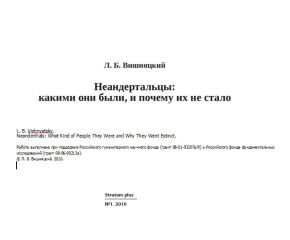Mazza P. P. A., F. Martini, B. Sala, M. Magi, M. P. Colombini,
Giachi, F. Landucci, C. Lemorini, F. Modugno, E. Ribechini. 2006. A new Palaeolithic discovery: tar-hafted stone tools in a European Mid-Pleistocene bone-bearing bed. Journal of Archaeological Science
Литература
33, 1310-1318.
Mellars P. 1996. The Neanderthal Legacy. An Archaeological Perspective from Western Europe. Princeton: Princeton University Press.
Mithen S. 1996. The Prehistory of the Mind. London: Thames and Hudson.
Mithen S. 2007. General intellectual ability. In: Gangestad S.W. and J.A. Simpson (eds.). The Evolution of Mind: Fundamental Questions and Controversies. New York and London: The Guilford Press, 319-324.
Noonan J. P., G. Coop, S. Kudaravalli, D. Smith, J. Krause, J. Alessi, F. Chen, D. Platt, S. Paabo, J. K. Pritchard, E. M. Rubin. 2006. Sequencing and analysis of Neanderthal genomic DNA. Science 314, 11131118.
Onac B. P., I. Viehmann, J. Lundberg, S.-E. Lauritzen, C. Stringer, V. Popita. 2005. U-Th ages constraining the Neanderthal footprint at Vartop Cave, Romania. Quaternary Science Reviews 24, 1151-1157.
Orlando L., P. Darlu, M. Toussaint, D. Bonjean, M. Otte, C. Hanni. 2006. Revisiting Neandertal diversity with a 100,000 year old mtDNA sequence. Current Biology 16, 400-402.
Orschiedt J. 2008. Der Fall Krapina — neue Ergebnisse zur Frage van Kannibalismus beim Neandertaler. Quartar 55, 63-81.
Pearson O. M. 2004. Has the combination of genetic and fossil evidence solved the riddle of modern human origins. Evolutionary Anthropology 13, 145-159.
Ponce de Leon M. S., L. Golovanova, V. Doronichev, G. Romanova, T. Akazawa, O. Kondo, H. Ishida, C. P. E. Zollikofer. 2008. Neanderthal brain size at birth provides insights into the evolution of human life history. Proceedings of the National Academy of Sciences of the USA 16, 13764-13768.
Rampino M. R. and S. Self. 1992. Volcanic winter and accelerated glaciation following the Toba supereruption. Nature 359, 50-52.
Richards M., K. Harvati, V. Grimes, C. Smith, T. Smith, J.-J. Hublin, P. Karkanas, E. Panagopoulou. 2008. Strontium isotope evidence of Neanderthal mobility at the site of Lakonis, Greece using laser-ablation PIMMS. Journal of Human Evolution 35, 12511256.
Rogers A. R., D. Iltis, S. Wooding. 2004. Genetic variation at the MC1R locus and the time since loss of human body hair. Current Anthropology 45,105-108.
Rolland N. 2004. Was the emergence of home bases and domestic fire a punctuated event? A review of the Middle Pleistocene record in Eurasia. Asian Perspectives 43, 248-280.
Rosas A., M. Bastir, C. Martinez-Maza, A. Garcia-Tabernero, C. Lalueza-Fox. 2006. Inquiries into Neanderthal craniofacial development and evolution: "accretion" versus “organismic" models. In: Harvati K. and T. Harrison (eds.). Neanderthals Revisited: New Approaches and Perspectives. Dordrecht: Springer, 37-69.
Royer D. F., C. A. Lockwood, J. E. Scott, F. E. Grine. 2009. Size variation in early human mandibles and molars from Klasies River, South Africa: Comparison with other Middle and Late Pleistocene assemblages and with modern humans. American Journal of Physical Anthropology 140, 312-323.
Rushton J. P. 1997. Race, Evolution, and Behavior: A Life History Perspective. 2nd ed. New Brunswick, NJ: Transaction Publishers.
Sawyer G. J. and B. Maley. 2005. Neanderthal reconstructed. The Anatomical Record 283B, 23-31.
Schmitz R. W. 2006. The discovery of fossil man in the 1841 and 19th century. In: Schmitz R.W. (ed.). Neanderthal 1856-2006. Mainz am Rhein: Verlag Philipp von Zaibern, 9-16.
Semendeferi K., H. Damasio, R. Frank, G. W. van Hoesen. 1997. The evolution of the frontal lobes: a volumetric analyses based on three dimensional reconstructions of magnetic resonance scans of human and ape brains. Journal of Human Evolution 32, 375-388.
Shen G., W. Wang, H. Cheng, R. L. Edwards. 2007. Mass spectrometric U-series dating of Laibin hominid site in Guangxi, southern China. Journal of Archaeological Science 35, 2109-2114.
Speth J. D. and E. Tchernov. 2001. Neandertal Hunting and Meat-Processing in the Near East: Evidence from Ke- bara Cave (Israel). In: Stanford C. B. and H. T. Bunn (eds.). Meat-Eating and Human Evolution. Oxford: Oxford University Press, 52-72.
Stormer F. C. and I. Mysterud. 2006. Cave smoke: air pollution poisoning involved in Neanderthal extinction? Medical Hypotheses 66, 723-724
Tattersall I. 1995. The Last Neanderthal. The Rise, Success, and Mysterious Extinction of Our Closest Relatives. New York: Macmillan.
Tattersall I. 2006. Neanderthal skeletal structure and the place of Homo neanderthalensis in European hominid phylogeny. Human Evolution 21, 269-274.
Thieme H. 1997. Lower Palaeolithic hunting spears from Germany. Nature 385, 807-810.
Thieme H. 2005. The Lower Palaeolithic art of hunting. The case of Schoningen I 3 II-4, Lower Saxony, Germany. In: Gamble C. and M. Porr (eds.). The hominid individual in context. Archaeological investigations of Lower and Middle Palaeolithic landscapes, locales and artifacts. New York: Routledge, 115-132.
Trinkaus E. 1997. Appendicular robusticity and the paleobiology of modern human emergence. Proceedings of the National Academy of sciences of the USA 94, 13367-13373.
Trinkaus E. 2005. Early modern humans. Annual Review of Anthropology 34, 207-230.
Underdown S. 2008. A potential role for transmissible spongiform encephalopathies in Neanderthal extinction. Medical Hypotheses 71, 4-7.
Voisin J.-L. 2006. Speciation by distance and temporal overlap:a new approach to understanding
Neanderthal evolution. In: Harvati R. and T. Harrison (eds.). Neanderthals Revisited: New Approaches and Perspectives. Dordrecht: Springer, 299-314.
Weaver T. D. and C. C. Roseman. 2008. New developments in the genetic evidence for modern human origins. Evolutionary Anthropology 17, 69-80.
Weaver T. D. and K. Steudel-Numbers. 2005. Does climate or mobility explain the differences in body proportions between Neandertals and their Upper Paleolithic successors? Evolutionary Anthropology 14, 218-223.
Weaver T. D., C. C. Roseman and C. B. Stringer. 2007. Were neandertal and modern human cranial differences produced by natural selection or genetic drift? Journal of Human Evolution 53, 135-145.
Williams M. A. J., S. H. Ambrose, S. van der Kaars, C. Ruehlemann, U. Chattopadhyaya, J. Pal, P. R. Chauhan. 2009. Environmental impact of the 73 ka Toba super-eruption in South Asia. Palaeogeography, Palaeoclimatology, Palaeoecology 284, 295-314.
Wynn T. and F. L. Coolidge. 2004. The expert Neandertal mind. Journal of Human Evolution 46, 467-487.
Литература
Zilhao J. 2006. Neandertals and moderns mixed, and it matters. Evolutionary Anthropology 15, 183-195.
Zollikofer C. P. E., M. S. Ponce de Leon, B. Vandermeersch, F. Leveque. 2002. Evidence for interpersonal violence in the St. Cesaire Neanderthal. Proceedings of the National Academy of Science of the USA 99,
6444-6448.
Zubrow E. 1989. The demographic modelling of Neanderthal extinction. In: Mellars P. and C. Stringer (eds.). The Human Revolution. Behavioral and Biological Perspectives on the Origins of Modern Humans. Edinburgh: Edinburgh University Press, 213-231.
Монография поступила в номер 5 декабря 2009 г.
Leonid Vishnyatsky (St.-Petersburg, Russia). Doctor of historical sciences. History of Material Culture Institute, Russian Academy of Sciences.
Leonid Vishnyatsky (S.-Petersburg, Rusia). Doctor m §tiinte istorice. Institutul de istorie a culturii materiale, Academia de §tiinte a Rusiei.
Вишняцкий Леонид Борисович (Санкт-Петербург, Россия). Доктор исторических наук. Институт истории материальной культуры РАН (ИИМК РАН).
E-mail: [email protected]
О некоторых, впрочем, можно хотя бы строить догадки. Например, в 1853 г. Ф. Спринг, профессор физиологии льежского университета, описал человеческие кости, найденные в одной из пещер близ Намюра в Бельгии. Кости были столь ветхими, что буквально рассыпались в руках. Говоря о черепе, Спринг отметил покатый лоб и необычайно большую носовую полость, и отнес его к некоей вымершей расе (Schmitz 2006: 13). Может быть, на самом деле льежский профессор держал в руках череп неандертальца?
В начале XX века немое “h” выпало из немецкого слова “thal” (долина), а в 1952 г. француз А. Валлуа и американец У. Хауэл предложили изменить соответствующим образом и написание названия «неандерталец» — “Neandertal”. Некоторые авторы вняли этому призыву, но большинство по-прежнему придерживается традиционной транскрипции — “Neanderthal”.
Этот рассказ, насколько мне известно, не переводился на русский язык. В оригинале он называется “The Grisly Folk”.
Правда, некоторые из этих образов выглядят отталкивающими лишь внешне. Так, в уже упомянутом романе У. Голдинга «Наследники» (1955) неандертальцы, несмотря на полную звероподобность их облика, показаны добрыми безобидными существами, связанными между собой узами любви и чуждыми какой бы то ни было агрессии по отношению к окружающему их миру. Вполне «человечны» и неандертальцы, изображенные в известном романе Джин Ауэл «Клан пещерного медведя» (1980), легшем в основу одноименного фильма.
Я называю их зыбкими, поскольку, на мой взгляд,
Эту точку зрения в той или иной степени разделяет сейчас большинство антропологов, но есть у нее и оппоненты. По их мнению, эволюция европейских гоминид в среднем плейстоцене шла по нескольким независимым линиям, и неандертальцы — лишь одна из них, просуществовавшая дольше всех (см., напр.: Tattersall 2006: 273). В принципе вполне возможно, что так и было, и что часть европейских гоминид рассматриваемого периода, действительно, не имела прямого отношения к филогенезу неандертальцев, но находки из Симы, Сванскомба, Штейнгейма и большинства других пунктов, включенных в таблицу 3.2, вряд ли входят в эту часть.
Кольцевидная молекула митохондриальной ДНК содержит всего лишь шестнадцать с половиной тысяч пар нуклеотидных оснований, тогда как в ядерных хромосомах их свыше трех миллиардов.
В 2009 г. то же самое удалось сделать с мтДНК еще пяти неандертальцев (Briggs et al. 2009).
Замечу на всякий случай, что слово «оледенение», когда оно используется в качестве названия той или иной геологической эпохи, не следует понимать буквально, как указание на то, что ледники якобы сплошь покрывали всю землю. Площадь, занимаемая ледниками, в такие эпохи, действительно, увеличивалась и иногда очень значительно, но при этом даже в северном полушарии большая часть поверхности суши оставалась все же свободной ото льда.
Хотя формально голоцен является понятием, иерархически равнозначным плейстоцену, фактически он представляет собой всего лишь очередное межледниковье.
Об ареале и времени существования пещерных медведей см.: Барышников 2007: 326-327.
Подробнее об этом говорится в одной из глав моей книги «История одной случайности, или Происхождение человека» (Фрязино, издательство «Век-2», 2005).
О том, что обработка дерева была для неандертальцев вполне обычным занятием, свидетельствует и изучение следов износа на их каменных орудиях (см. напр. Семенов 1968: 104-105; Anderson-Gerfaud l990: 401- 404).
Впрочем, Джин Ауэл, прежде чем взяться за перо, сделала все возможное, чтобы как можно лучше представить жизнь своих будущих персонажей. Она не только изучила горы антропологической и археологической литературы, не только поучаствовала в раскопках палеолитических памятников, но и прошла специальный курс выживания вне цивилизации, где обучилась разным премудростям первобытного быта, в том числе и тому, как обрабатывать шкуры и делать из них разные полезные вещи.





